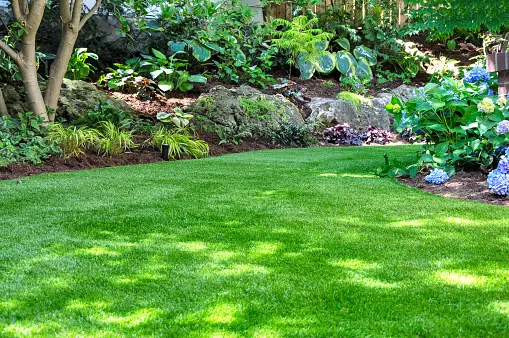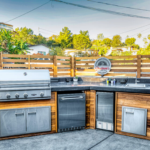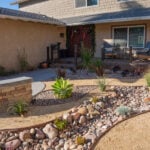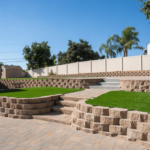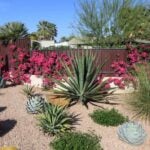The Art of Balancing
Landscape design is an enthralling fusion of creativity and pragmatism where nature and human innovation meet. It’s a field that combines aesthetics and utility to design outdoor areas that are both pleasing to the eye and useful. The fundamental core of landscape design is found in the fine line that separates the two. In this article, we explore the complexities of balancing aesthetics and utility in landscape design.
Aesthetic Delights
Aesthetics are crucial to landscape design because they capture the essence of aesthetic appeal and beauty. It entails the purposeful placement of components such as plants, hardscapes, water features, and sculptures to produce a pleasing composition. Aesthetic principles guide designers on for example balance, unity, contrast, rhythm, and size as they create environments that arouse emotion and enrich their surroundings.
- Balance and Unity: Achieving balance in landscape design entails distributing visual weight evenly across a space. It can be symmetrical, where elements are mirrored on both sides or asymmetrical, where visual equilibrium is attained through careful selection and placement of elements. Unity, on the other hand, ensures that all components work harmoniously to convey a single theme or style.
- Contrast and Rhythm: Contrast introduces variety and excitement into a landscape, often through the juxtaposition of different textures, colors, or forms. Rhythm, akin to musical rhythm, leads the eye from one area to another through repeated patterns or gradual transitions.
- Scale and Proportion: Scale relates to the size of elements in relation to each other and the overall space. Proportion ensures that the size of each element is appropriate to its function and the surrounding environment, maintaining a pleasing visual balance.
Functionality at its Finest
Any landscape design must be functional since it affects how well the area may be used and enjoyed. Layout, circulation, and the incorporation of components that satisfy consumers’ requirements and wants all require practical considerations to be made.
- Layout and Circulation: The layout of a landscape should facilitate movement and access. Paths, walkways, and seating areas need to be strategically placed to guide users through the space and encourage interaction with various elements. Accessibility for all, including individuals with disabilities, is an essential consideration in modern landscape design.
- Zoning and Practical Use: Zoning divides a landscape into functional areas, each with a specific purpose. These zones can include spaces for entertaining, gardening, relaxation, and more. The practical use of these zones influences the placement of elements like patios, decks, outdoor kitchens, and play areas.
- Environmental Sustainability: In the contemporary landscape design ethos, sustainability has taken center stage. Functional landscapes incorporate environmentally friendly practices like rainwater harvesting, the use of native plants, and energy-efficient lighting systems. These elements not only enhance functionality but also contribute to the overall health of the ecosystem.
Finding Harmony
The ultimate art of landscape design is in the seamless blending of aesthetics and functionality, producing areas that are both aesthetically pleasing and extremely functional. Here are some techniques designers have used to achieve this delicate balance:
- Purpose-Driven Design: A successful design begins with a clear understanding of the intended purpose of the landscape. Is it meant for relaxation, entertainment, or recreation? By identifying the primary function, designers can prioritize elements that contribute to that purpose while ensuring they align aesthetically.
- Form Follows Function: This age-old principle in design asserts that the form or appearance of an object should be dictated by its intended function. Applying this to landscape design means that the visual aspects should complement and enhance the practical use of the space.
- Adaptability and Flexibility: Designing with adaptability in mind allows a space to evolve over time. Plants grow, families change and needs shift. Incorporating flexible design elements ensures that the landscape remains functional and aesthetically pleasing through these transformations.
- Native Plant Selection: Choosing native plants not only supports local ecosystems but also contributes to a more harmonious design. Native plants adapt well to the local climate, reducing the need for excessive maintenance and creating a seamless connection between the landscape and its surroundings.
- Sculptural and Architectural Elements: Integrating sculptures, pergolas, trellises, and other architectural elements adds a layer of artistry to the landscape. These structures can serve dual purposes, such as providing shade while also acting as visual focal points.
- Materials and Textures: The selection of materials, such as paving stones, wood, and metal, impacts both the aesthetic and functional aspects of a landscape. Textures add depth and interest to the visual composition, while the choice of materials affects durability and maintenance requirements.
The Perfect Blend
An important requirement is a delicate tango between the aesthetic and the practical. This makes sure to successfully balance aesthetics and usefulness in landscape design. Successful designs provide spaces that enhance the lives of individuals who occupy them. They also in addition help to engage the senses and evoke emotions. With a thorough awareness of aesthetics, user demands, and environmental factors, landscape designers may create outdoor havens that are both works of art and technological marvels. The seamless integration of aesthetics and practicality becomes an ever-more-important component of landscape design as our awareness of nature’s beauty and our need for useful outdoor places expand.

